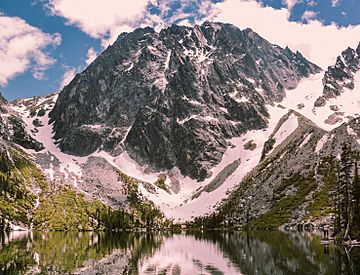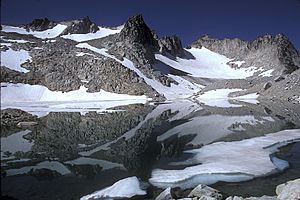Dragontail Peak facts for kids
Quick facts for kids Dragontail Peak |
|
|---|---|

Dragontail Peak seen from Colchuck Lake
|
|
| Highest point | |
| Elevation | 8,840+ ft (2,690+ m) NGVD 29 |
| Prominence | 1,760 ft (540 m) |
| Geography | |
| Location | Chelan County, Washington, U.S. |
| Parent range | Cascades |
| Topo map | USGS Enchantment Lakes |
| Geology | |
| Age of rock | Cretaceous |
| Mountain type | Granite |
| Climbing | |
| Easiest route | Scramble |
Dragontail Peak, also called Dragon Tail, is a tall mountain in the Stuart Range. It is located in Chelan County, Washington, in the United States.
The mountain got its name from three climbers: Lex Maxwell, Bob McCall, and Bill Prater. While they were climbing nearby, they noticed some pointy rock formations on the mountain's crest. These rocks looked just like a "dragon tail"! The name was officially accepted in 1955.
On the northeast side of Dragontail Peak, you'll find Colchuck Lake. This lake flows into Mountaineer Creek. Below the western slopes of the peak is the Colchuck Glacier. On the south side, the mountain drops very steeply down to Ingalls Creek. This creek flows about 5,800 feet (1,800 m) below the mountain's top.
Dragontail Peak is part of the Alpine Lakes Wilderness. It sits near other mountains like Colchuck Peak, Little Annapurna, and Cannon Mountain. The mountain is made of granite, a very hard rock that forms the Stuart Range. Dragontail is the second highest mountain in this range. The tallest is Mount Stuart, which is about 3.2 miles (5.1 km) to the west and reaches 9,415 feet (2,870 m) high.
The "dragon tail" rocks are a challenge for experienced climbers. They require many long sections of climbing to get to the top. The area around Dragontail Peak is a protected wilderness, meaning it's kept wild and natural.
The Enchantments area, located northeast of Dragontail, is a beautiful place with huge peaks, snow all year, and clear alpine lakes. It's a very important part of the Alpine Lakes Wilderness.
Weather at Dragontail Peak
Most of the weather that affects Dragontail Peak comes from the Pacific Ocean. These weather systems travel east towards the Cascade Mountains. When they hit the tall peaks of the Cascades, the air is forced to rise. As the air goes up, it cools down and drops its moisture as rain or snow. This process is called Orographic lift.
Because of this, the Cascade Mountains get a lot of rain and snow, especially in winter. Winters are usually cloudy. However, during the summer, high-pressure systems over the Pacific Ocean often bring clear skies. The snow here tends to be wet and heavy because of the ocean's influence. This can make avalanches more likely.
How Dragontail Peak Was Formed

The Alpine Lakes Wilderness has some of the most rugged land in the Cascade Range. You can see jagged peaks, deep valleys carved by glaciers, and granite walls. There are also over 700 mountain lakes! All these different features and big changes in height were created by amazing geological events that happened millions of years ago.
The Cascade Mountains started to form millions of years ago, during the late Eocene Epoch. At that time, the North American Plate was slowly moving over the Pacific Plate. This movement caused a lot of volcanic activity. Also, small pieces of the Earth's crust, called terranes, joined together to form the North Cascades about 50 million years ago.
Later, during the Pleistocene period (which started over two million years ago), huge sheets of ice called glaciers moved across the land many times. As they moved, they scraped and shaped the landscape, leaving behind rocks and debris. The last glaciers in the Alpine Lakes area began to melt and move away about 14,000 years ago. By 10,000 years ago, they were north of the Canada–US border.
The river valleys in this area have a "U" shape. This shape was created by these recent glaciers. The combination of the land being pushed up (orogeny) and cracks forming in the Earth's crust (faulting), along with the action of glaciers, has created the tall peaks and deep valleys you see in the Alpine Lakes Wilderness today.
Images for kids



